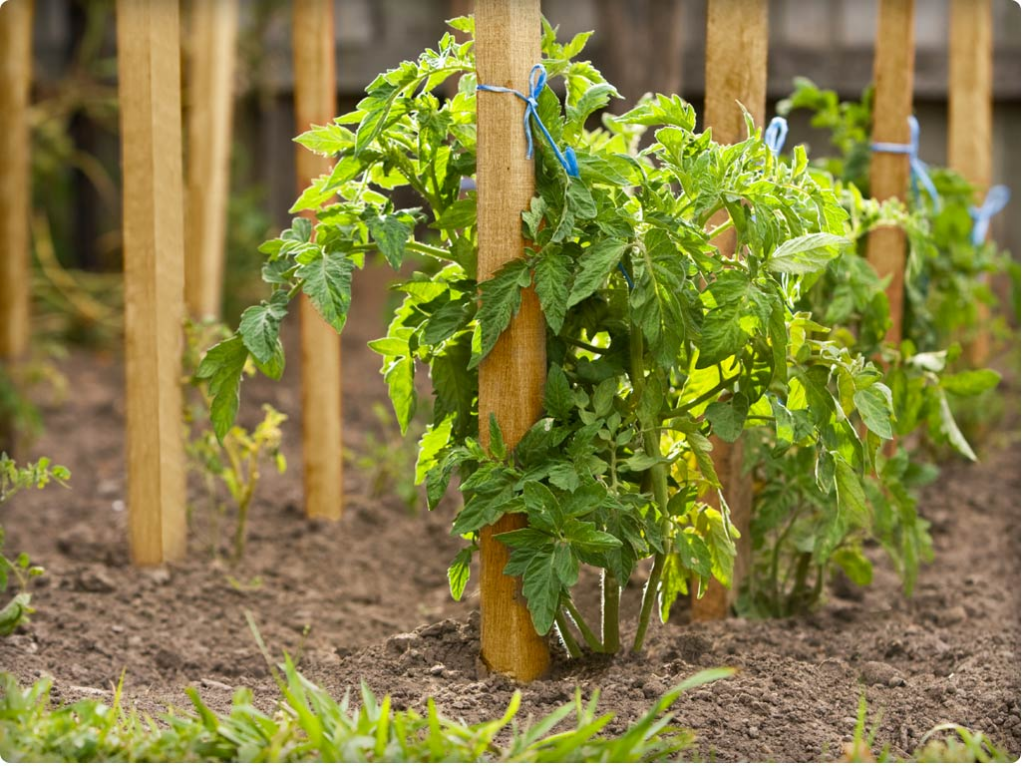Many plants need structural support to maintain upright growth, especially those with tall, weak stems, heavy blooms, or climbing habits. Proper structural support helps these plants grow healthily, prevents breakage, and makes it easy to harvest or maintain them.
Garden stakes are slim, long wooden, metal, bamboo, or plastic supports used in gardening and landscaping to provide structural support, define areas, and mark boundaries. They prevent damage to stems and promote better growth.
Growcycle provides very aesthetic garden stakes. These stakes are made from quality materials and support the upright growth of plants, improving their overall appearance.
Garden stakes
Types of Garden Stakes
Garden stakes come in various forms, each used for specific purposes. Here are the most common types:
1. Wooden Stakes
These are made from untreated or treated wood, such as cedar or pine. They are ideal for supporting vegetables like tomatoes and peppers. They are strong, have a natural appearance, and can be recycled.
2. Bamboo Stakes
These are made from natural bamboo and are perfect for lightweight plants and vines. They are beneficial because of their lightweight, flexibility, sustainability, and low cost.
3. Metal Stakes
Metal stakes are made from steel, aluminum, or other durable metals. These are suitable for heavy plants, trees, or in windy areas. They are strong, long-lasting, and weather-resistant.
4. Plastic Stakes
Plastic stakes are made of polyvinyl chloride or other solid plastics. They are primarily used in flower beds or small gardens and are lightweight, weather-resistant, and reusable.
5. Fiberglass Stakes
Fiberglass stakes are made from fiberglass composite and used for ornamental and functional purposes. They are durable, lightweight, and resistant to weather changes.
6. Decorative Stakes
Decorative stakes are made from wood, metal, or plastic with ornamental designs and add aesthetic appeal to support plants. They combine functionality with decoration.
Decorative Garden stakes
Benefits of Using Garden Stakes
Garden stakes offer many benefits, making them an essential tool for gardeners. Here are some of its common benefits:
Supports Upright Growth
Many plants naturally grow tall or produce heavy fruits and flowers that their stems cannot support. Without stakes, these plants may bend or break, and weak stems can collapse under the weight of blooms or fruits.
Wind, rain, or physical disturbances can also damage tall plants. Stakes provide structural support, allowing plants to grow upright and maintain their natural shape.
Higher Yields
Vegetable and fruit-bearing plants benefit significantly from staking, which improves their overall productivity. Upright plants have better access to sunlight, leading to increased photosynthesis and more vigorous growth, which increases their overall yield.
Promotes Air Circulation
Dense, unstructured plant growth can create a humid environment that can lead to the development of fungal diseases like powdery mildew or blight. Staking plants improves ventilation and allows air to circulate freely around leaves and stems. Dry leaves are less likely to develop fungal infections, keeping plants healthier.
Protects Plants from Physical Damage
Unstaked plants are vulnerable to various forms of damage. People or animals can accidentally step on sprawling plants, and mowers, trimmers, or hoses can easily damage plants lying on the ground. Stakes act as a physical barrier, marking the plant’s location and keeping it safe from accidental harm.
Saves Space
Garden stakes are essential to vertical gardening, particularly useful for small spaces. They encourage plants to grow vertically, saving valuable ground space. They also keep plants neat and organized, making the garden easier to walk through.
Simplifies Garden Maintenance
Staked plants are easier to manage, reducing the effort and time required for gardening tasks. They also allow for easier access to stems and leaves that need trimming. Staked plants ensure the targeted application of water and nutrients and minimize waste.
Improves Aesthetics
A neat and clean garden is more visually appealing, and stakes contribute to this by maintaining plant shape and preventing plants from sprawling. Rows of neatly staked plants create a professional, well-maintained look. Many stakes are designed with aesthetic elements like colors, patterns, or beautiful designs, adding a decorative touch to the garden.
Increases Accessibility
Staking can make gardening more accessible for gardeners with limited space. Fruits and vegetables supported by stakes are easier to pick without bending, and raised plants are simpler to inspect for pests, diseases, or nutrient deficiencies.
Reduces Pest Problems
Garden stakes also help to minimize pest infestations by keeping plants off the ground. Rodents, slugs, and other ground-dwelling pests are less likely to reach staked plants, and lifting plants off the soil reduces contact with harmful pathogens and insects.
Garden Stakes
Plants That Need Support from Garden Stakes
Certain plants naturally require structural support due to their growth habits or the weight of their flowers or fruits. These include:
- Vegetables: Tomatoes, cucumbers, beans, peas, and peppers.
- Flowers: Sunflowers, dahlias, delphiniums, and gladiolus.
- Climbing and Vining Plants: Clematis, morning glories, and ivy.
- Fruits: Grapes, blackberries, raspberries, and melons.
Choosing the correct stake and staking method for each type ensures healthy growth and a robust harvest.
How to Use Garden Stakes Effectively
To maximize the benefits of garden stakes, it is essential to use them correctly. Here are some practical tips:
- Choosing the Right Stake: Match the stake material and size to the plant’s growth requirements. Bamboo stakes are used for lightweight climbers, and metal stakes are used for heavy-fruiting plants.
- Proper Placement: Insert stakes into the ground before planting to avoid damaging roots later. For existing plants, place stakes carefully to minimize disruption.
- Tying Plants: Attach plants to stakes using soft ties, such as garden twine, cloth strips, or plant ties. Avoid tying too tightly, as this can damage stems.
- 4. Regular Adjustment: Check and adjust ties regularly to help the plant’s growth and prevent tightness.
- Combining Stakes with Other Supports: Use stakes in combination with cages or nets for plants that require additional stability, such as tomatoes or climbing beans.
Garden stakes
FAQs
How can stakes be prevented from rotting or rusting?
Use treated or weather-resistant materials, such as metal or coated wood. Apply a protective sealant to wooden stakes. Store stakes indoors during off-seasons to minimize exposure to moisture.
What are decorative garden stakes?
Decorative garden stakes are functional supports that also improve the garden’s appearance. They feature artistic designs, vibrant colors, or ornaments such as butterflies, birds, or solar lights.
Are garden stakes safe for the environment?
Choose sustainable materials like bamboo and untreated wood that are biodegradable and eco-friendly. Avoid single-use plastic stakes and choose reusable or recyclable materials.
The Bottom Line
Garden stakes are invaluable tools for new and experienced gardeners. They help support plants, improve garden organization and aesthetics, and offer numerous benefits that contribute to a thriving garden.
Visit Growcycle to choose the right type of stake and use it effectively to ensure healthier plants, higher yields, and a more enjoyable gardening experience.



